Making Maple Syrup in Vermont

Sugaring. For those unfamiliar with the word, it is Vermont speak for making maple syrup.
But for Vermonters, it is one word that conjures emotional memories of steam-filled cabins and, for those more romantically inclined, a horse towing a tank on a sleigh through a snow-covered forest. The forest of maple trees, modernly connected by tubing, yields thousands of gallons of sap to be boiled down to the sweet nectar best known for topping pancakes. The simplicity of it all belies the days of toil and hard work to turn the tree juice into pure maple syrup.
But who am I to tell you about making maple syrup? As with so many Vermont kids, my first experience of sugaring was with just a few buckets in my backyard. If that was the totality of my syrup-making expertise this would be a short article. However, in 2009 my life took a new, unplanned course.
Familiar Woods

Today, the woods around Cochran Ski Area are a network of well-known bike trails and sap pipelines, but in 2010 there was no tubing and only a couple rudimentary trails known to a select few. To me, those woods might as well have been a remote jungle. My childhood had been spent being reprimanded for wandering into even just the edge of the woods.
But in 2009, my family had a forestry survey done of the 600 acres of land surrounding the ski area which showed the potential for a, at the time, mid-sized commercial maple farm. The woods that were once forbidden would soon become some of the most familiar I have ever known.
Four of the Cochran cousins (I amongst them) teamed up to try our hand at Vermont’s most recognizable profession. In the first year of Slopeside Syrup, we milled timbers from the land and built an 800 square foot sugarhouse (the building where you boil sap down to syrup) and installed almost 25 miles of tubing in organized chaos over about 100 acres.
Unspool the Tubing
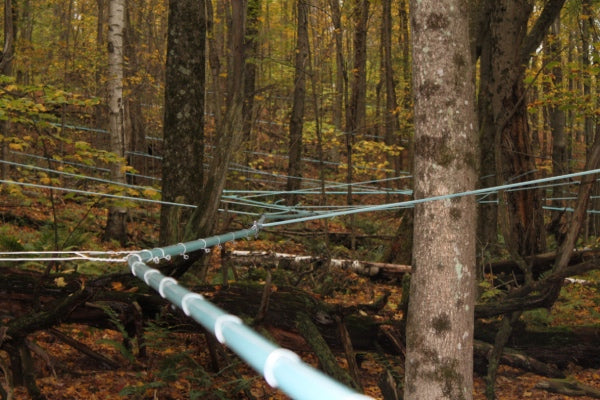
Most agricultural endeavors require long hours of hard work, but with the work of sugaring being confined to forests (and our forest being on the side of a steep hill), little work can be aided by machinery, making it incredibly labor-intensive.
The first step in collecting maple syrup is setting up the infrastructure. Few modern sugaring operations use any appreciable amount of the traditional buckets, so this means installing tubing throughout the forest.
One thousand foot rolls of ¾” tubing have to be unspooled and pulled by hand across a sidehill while maintaining a 3% grade and staying 100 feet away from the previous line and zigzagging through trees. On an hourly basis, while pulling hundreds of pounds of force against the tubing, my feet would slip away, sending me careening into mud pits or brush piles.
Every 18 inches, the tubing has to be tied to a wire (stretched out previously) so that the sap can flow downhill at a gentle grade without any dips in the tubing. This ¾” tubing is the access point for the smallest lines that actually connect to each tree, and in turn connects to a system of larger tubing that carries the sap straight down the hill to the tanks at the sugarhouse.
Connect the Dots
Picture standing on a forested hillside divided into 100 foot swathes with a 500 foot long, 30 pound roll of tubing cradled in one arm, a connection tool in the other hand. There are no marks on the trees.
“Is that a red maple? Or an old beech?”
Your mind begins to get fuzzy from staring at trees for hours on end. “Should I zag this line over to that tree or connect it by itself? There are already 5 trees on this line, but that tree is right here.”
It is a game of connect the dots, but you have to make up which dots are supposed to be connected and how.
Slowly but surely the spider web grows until you cannot stand the idea of going for a hike. And yet you have to keep on trudging through the rain, heat, snow, and frost. Days are made even longer when, for instance, a tool falls from your work belt into the feet of snow, so you then spend hours looking for it.
The Gear
If one ever needs to test the durability of workwear or any tool, sugarmakers are the best guinea pigs. ATVs will get transmissions destroyed. Pants will be shredded. Boots will be worn to nothing.
With physical work being required year-round in all weather conditions, the gear required is varied and voluminous. In the summertime, shorts and t-shirts need to be augmented with strong tick repellent (Lyme disease is a common affliction of sugarmakers). In the deep cold of January, thermals and coats takeover.

Some common threads persist year-round: strong footwear keeps ankles safe and feet planted firmly; a good pair of merino wool socks (my favorite are the Darn Tough tactical socks) keep feet at the perfect temperature; and good food to stay fueled through long days (fortunately maple also makes a great fuel - check out UnTapped).
Poor fueling or cold, wet feet can cut short otherwise valuable productive days.
Approaching Spring
Finally the days start to feel a little longer, and the sunshine feels warmer, and it is time to walk to every single tree, drill a hole, and connect the tubing. A good day from dawn to dusk can yield 500 trees tapped, 4 dead drill batteries, and two exhausted arms.

As the thermometer creeps above freezing, the sap begins to thaw and flow into the tubing to be collected in massive tanks next to the sugarhouse. A vacuum pump helps pull the sap from the tree, but the squirrels and porcupines have spent the summer chewing on the tubing – calling for more hiking through the woods looking for everything from completely destroyed tubing to the smallest pinholes, all of which have to be fixed to keep the vacuum high.
Refining Sap
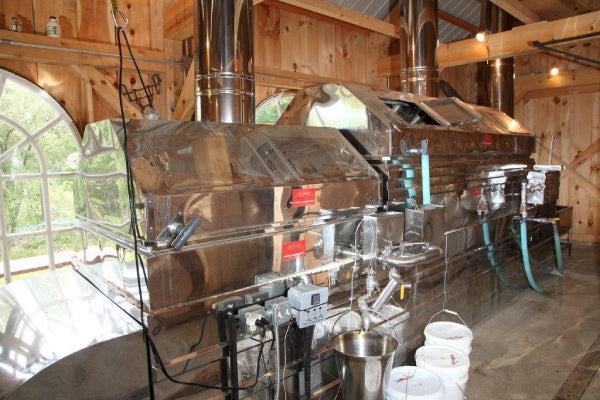
After long days in the woods, attention must be turned to the tanks, which can be close to overflowing. Sap from the tree is usually about 1-2% sugar and has to be concentrated to 67% sugar (by Vermont law) to be considered syrup.
The first step is reverse osmosis (sap is pumped at high pressure across fine membranes) to remove most of the water and yield 16 to 20% sugar concentrate. The RO saves about 90% of the boiling time and energy (both human energy and fuel oil).
The concentrated sap then flows into a series of pans designed to extract as much heat as possible from the 20 gallons of fuel oil per hour burning underneath.
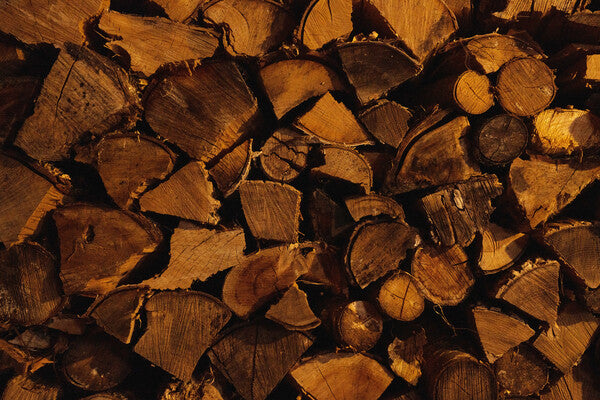
The Syrup
The boiling sap flows slowly through a maze of chambers that creates a long path with the beginning input of sap slowly losing water and gaining sweetness and flavor to the final syrup flowing from the end.
This boiling process results in the steam-filled sugarhouses - a Vermont spa experience like no other. Many hours are spent monitoring the boiling sap with friends and family coming regularly to bask in the sweet smell of maple. The boiling sap can’t be left alone because it can quickly turn to burning sugar. No sugarmaker will ever admit to burning a pan, but they have all done it (except, of course, for me).

As the sap loses water, it becomes more dense and boils at a higher temperature - both things that are used to test for the correct sugar content. An experienced sugarmaker can judge the boiling syrup to get an idea of how close it is to finished, but the true test is done with a hydrometer or refractometer that can show the exact amount of sugar in the syrup.
When finally judged to be syrup, it is pumped through a filter to remove impurities that have come out of solution during the boiling and into a barrel, where it will be stored until it is needed to fill the bottles that will be sent to grace a breakfast table or put in a packet to fuel a run or ride (or a hike to fix some tubing).
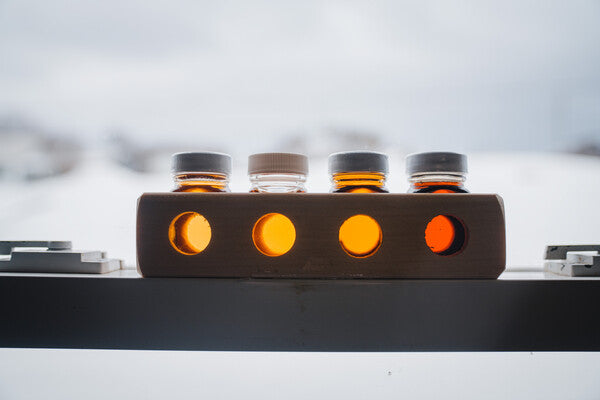
About the Author
Doug Brown is a co-founder of Slopeside Syrup and CEO of UnTapped. Doug lives in Waterbury Center, VT, and is passionate about maple syrup (there is no real/fake, just maple syrup or flavored corn syrup). He enjoys spending time in the mountains of Vermont close to the trees that are the base of all his work and getting to meet people around the country to talk about maple syrup and how to fuel naturally.
About Slopeside Syrup & Untapped
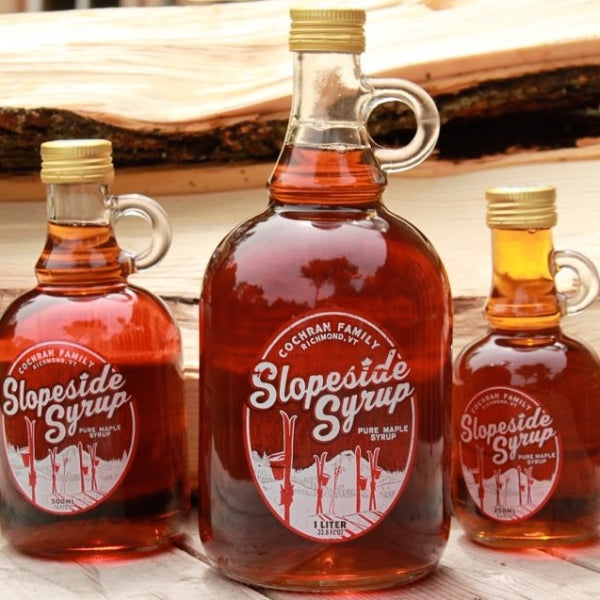
From the small beginnings of the sugarhouse next to Cochran’s, Slopeside has grown to work with dozens of local sugarmakers to provide Pure Vermont Maple Syrup to restaurant tables and home kitchens across the country. UnTapped, a partnership between Slopeside Syrup, pro-cyclist Ted King, and nordic ski coach Andrew Gardner, harnesses the power of maple syrup to fuel cyclists, runners, and hikers (or anyone) looking for a natural energy source.







